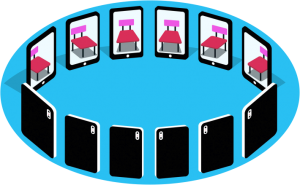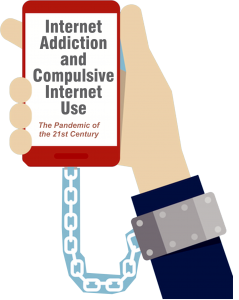Internet Addiction and
Compulsive Internet Use
The Pandemic of
the 21st Century
We are living in the age of internet addiction, the 21st century, where we cannot stop ourselves from trolling Instagram posts, checking Facebook notifications, shopping online, watching thrilling seasons on Netflix, playing video games and getting inspired from the fashion sense of models and celebrities. This type of addiction causes social, academic and occupational impairments. Hence, we can say that most of us are suffering from compulsive internet use (CIU), also known as internet-addiction disorder or problematic internet use (PIU) or disorder.
Background
 Originally debated as a “real thing,” it was satirically theorized as a disorder by Dr Ivan Goldberg MD in 1995 who compared its original model to pathological gambling. This disorder has rapidly gained ground and attracted serious attention from many researchers, health counsellors and doctors. Though not officially recognized as a disorder, its prevalence has made it a serious issue demanding serious measures; just like those needed to cope with a disorder. According to reports, it has affected 38% of the global population. The widely variable difference in prevalence may have contributed to the fact that no true and standardized criteria have been selected. It is usually a technology addiction in general.
Originally debated as a “real thing,” it was satirically theorized as a disorder by Dr Ivan Goldberg MD in 1995 who compared its original model to pathological gambling. This disorder has rapidly gained ground and attracted serious attention from many researchers, health counsellors and doctors. Though not officially recognized as a disorder, its prevalence has made it a serious issue demanding serious measures; just like those needed to cope with a disorder. According to reports, it has affected 38% of the global population. The widely variable difference in prevalence may have contributed to the fact that no true and standardized criteria have been selected. It is usually a technology addiction in general.
 Internet addiction has symptoms like addiction to nicotine, cigarettes, caffeine, etc. When someone becomes addicted to the internet, (s)he will have increased tolerance to the amount of time spent online, withdrawal, mood changes between when online and off, and there will be an interruption of social relationships and activities.
Internet addiction has symptoms like addiction to nicotine, cigarettes, caffeine, etc. When someone becomes addicted to the internet, (s)he will have increased tolerance to the amount of time spent online, withdrawal, mood changes between when online and off, and there will be an interruption of social relationships and activities.
This addiction has been proved unhealthy as it causes many problems including mental illness, deprivation of sleep and aggression. Internet addiction can not only cause mental illness; it is itself regarded as a mental illness. One reason for such addiction is that it does not have constraints either by law or by social etiquettes. Take alcohol addiction, for example. Consuming alcohol while in office or at school is sure to land one in trouble; conversely, instant messaging or surfing the web is likely not to. Cultural influences both mandate and facilitate that we spend time online – meaning that teetotalism is not an option. Also, there is a genetic predisposition to behavioural addictions; we may be going a long way toward ensuring that the entire susceptible population develops them. According to research, specific subpopulations, including those with psychological comorbidities, e.g. attention-deficit hyperactivity disorder, depression and social isolation, are at increased risk. The risk factors lend further credence to the validity of the disorder, since they have been associated with other behavioural addiction as well as substance abuse.
 Some evidence suggests that if you are suffering from internet addiction disorder, your brain makeup is similar to those that suffer from chemical dependency, such as drugs or alcohol. Interestingly, some studies link internet addiction disorder to physically changing brain structure – specifically affecting the amount of grey and white matter in regions of the prefrontal brain. This area of the brain is associated with remembering details, attention, planning and prioritizing tasks. It is suggested that one of the causes of internet- addiction disorder is structural changes to the prefrontal region of the brain which are detrimental to your capability to prioritize tasks, rendering you unable to prioritize your life. CIU also seems to affect the pleasure centre of the brain. The addictive behaviour triggers a release of dopamine to promote the pleasurable experience activating the release of this chemical. Over time, more and more of the activity is needed to induce the same pleasurable response, creating a dependency. The other cause of internet addiction, according to Variable Ratio Reinforcement Schedule (VRRS) theory, is that it provides multiple layers of rewards. For instance, our addiction to Facebook provides multiple and unpredictable layers of rewards in the sense that every time we log in to read our updates, we get repeated and unexpected good news. Each sign gives us unpredictable results that keep us entertained and coming back for more.
Some evidence suggests that if you are suffering from internet addiction disorder, your brain makeup is similar to those that suffer from chemical dependency, such as drugs or alcohol. Interestingly, some studies link internet addiction disorder to physically changing brain structure – specifically affecting the amount of grey and white matter in regions of the prefrontal brain. This area of the brain is associated with remembering details, attention, planning and prioritizing tasks. It is suggested that one of the causes of internet- addiction disorder is structural changes to the prefrontal region of the brain which are detrimental to your capability to prioritize tasks, rendering you unable to prioritize your life. CIU also seems to affect the pleasure centre of the brain. The addictive behaviour triggers a release of dopamine to promote the pleasurable experience activating the release of this chemical. Over time, more and more of the activity is needed to induce the same pleasurable response, creating a dependency. The other cause of internet addiction, according to Variable Ratio Reinforcement Schedule (VRRS) theory, is that it provides multiple layers of rewards. For instance, our addiction to Facebook provides multiple and unpredictable layers of rewards in the sense that every time we log in to read our updates, we get repeated and unexpected good news. Each sign gives us unpredictable results that keep us entertained and coming back for more.
Symptoms
There are both emotional and physical signs and symptoms of this disorder. Emotional symptoms including dishonesty, depression, feeling of guilt, inability to keep schedule, isolation, defensiveness, no sense of time, shirking work, agitation, mood swings, loneliness and procrastination. Physical symptoms include backache, headache, insomnia, poor nutrition, poor personal hygiene, dry eyes and vision problem, neck pain and weight gain or loss.
Diagnostic
The most accepted diagnostic criteria for CIU to date were proposed by KW Beard’s 2005 article in Cyber Psychology and Behaviour. He proposed five diagnostic criteria:
1. Preoccupied with the internet (constantly thinking about past and future internet use).
2. Needs to use the internet with an increased amount of time to gain satisfaction.
3. Has made unsuccessful efforts to control, cut back, or stop the use of the internet.
4. Is restless, moody, depressed or irritable when attempting to control internet use.
5. Has stayed online longer than intended.
In addition, Beard suggested that at least one of the following must also be present in a diagnosis of internet- addiction disorder:
1. Has jeopardized or risked the loss of a significant relationship, job, educational or career opportunity because of the internet.
2. Has lied to members of family, therapists and others to conceal their involvement with the internet.
3. Uses the internet as a way of escaping from problems or to relieve a dysphoric mood (e.g. guilt, anxiety and depression).
Other diagnostic scales are Young’s internet addiction test, the problematic internet use questionnaire, compulsive internet use scale.
Treatment
The first step in the treatment is the recognition that the problem exists. If one does not believe that problem exists one is not likely to seek the treatment. There is debate in the literature whether treatment is necessary in the first place. Some suggest that CIU resolves itself on its own. Studies have shown that self-corrective behaviour can be achieved and is successful. Corrective behaviour includes software that controls internet use and types of sites that can be visited. Some others suggest that medications can be used for their treatment because if one is suffering from this condition, it is likely that one may be suffering from anxiety and depression. Studies have shown that anti-anxiety and antidepressants have a profound effect on the time spent on the internet. Physical activity has been indicative of increasing serotonin levels and decreasing the dependency on the internet. Some other treatment choices are:
Family therapy
Behavioural modification
Cognitive behavioural therapy
Art therapy
Recreational therapy
Conclusion
Though originally diagnosed as a hoax disorder, the increased digital age has propelled us into the internet age and internet addiction. Creating an even more problematic interaction is the fact that everything is online nowadays. It is hard to make a distinction between the online and offline worlds. Everything is internet-based. But still, we can take our measures to prevent excessive internet use. To counter the negative impacts of the internet, there are very simple steps that can be taken such as putting one’s phone on silent mode during study hours, switching off one’s phone and other internet devices while having dinner with family, engaging oneself in creative work like drawing, cooking and painting, going for morning or evening walks without one’s phone at these places, exercising once daily so that one’s body stays healthy, and limiting screen timing
 Jahangir's World Times First Comprehensive Magazine for students/teachers of competitive exams and general readers as well.
Jahangir's World Times First Comprehensive Magazine for students/teachers of competitive exams and general readers as well.



